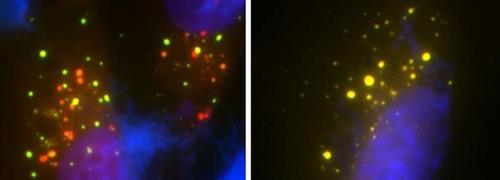MARK 2 enzyme that controls protein toxic stress response
PKC delta enzyme that stimulates MARK 2 is also… Journal’PLoS Biology’ paper

In neurodegenerative patients such as Parkinson’s disease and Alzheimer’s disease, or in the brains of elderly people, many deformed amphiphiles are observed.
The normal structure of the starch nutrient body is also used as a waste discharge container for the brain.
[스페인 바르셀로나대 제공/ 재판매 및 DB 금지]
(Seoul = Yonhap News) Reporter Ki-Cheon Han = It is estimated that there are far more than 50 million people in the world with neurodegenerative diseases such as Alzheimer’s disease and ALS (aka Lou Gehrig’s disease).
Nevertheless, aside from the fundamental drugs for neurodegenerative diseases, there is no cure to slow the progression of the disease.
This is because, above all, we do not know exactly what causes neurodegenerative diseases.
Scientists at the Bloomberg School of Public Health at Johns Hopkins University have discovered a “molecular switch” enzyme that regulates the stress response of cells.
The stress response of cells is considered to be a potent factor in causing apoptosis and neurodegenerative diseases.
This enzyme, called MARK 2, is likely to be a new target for scientists looking for a treatment for neurodegenerative diseases.
The results of this study were published in the peer-reviewed journal’PLoS Biology’ on the 11th (local time).
The research team focused on the cellular response to proteotoxic stress, a key characteristic of neurodegenerative diseases.

ALS is associated with mutations in the UBQLN2 gene.
This gene is known to regulate the processing of cellular waste products such as misfolded proteins.
The red dots on the left cell, where the UBQLN2 gene is normal, show that the trash removal pathway works well.
No red dot is visible on the right cell of the mutation.
[미 메릴랜드 의대 제공 / 재판매 및 DB 금지]
Protein toxic stress is the buildup of damaged (misfolded) proteins in key areas of the cell.
When cells actively respond to protein toxic stress, the amount of protein produced decreases, and the stress can be overcome.
However, if a problem occurs in the stress response and the reduction of protein synthesis continues for a long period of time, the cells fall into protein deficiency, which leads to cell damage and cell death.
Conversely, too many proteins can cause cell damage and death, even without a protein-toxic stress response.
So, the research team aimed to identify the signaling pathway that manipulates the stress response switch by detecting protein toxic stress.
We already knew that there are several kinases that switch down the protein synthesis switch in this signaling pathway.
However, these kinases are involved in other types of cellular stress responses, such as viral infection.
The research team searched the data base that accumulated the results of previous studies and selected five candidate kinases. After repeating the cultured cell and cell-free experiments, MARK 2 was selected as the sole candidate.
MARK 2 responded to protein toxic stress in the absence of the other four, and switched off the cellular system that produced the protein.

Astrocytes in the brain are involved in the removal of waste products, phagocytosis, and nerve tissue repair.
However, when a neurodegenerative disease occurs, astrocytes kill neurons.
[뉴욕 줄기세포 재단 연구소 제공 / 재판매 및 DB 금지]
By closely monitoring the upstream of the signaling pathway, the researchers also found a kinase called PKC delta that stimulates and activates MARK 2 when protein toxic stress occurs.
The PKC delta served as a sensor to detect protein stress.
When tested in a mouse model engineered to produce familial ALS and a sample of spinal cord tissue from a real Alzheimer’s patient, this PKC delta-MARK 2 pathway was very strongly activated.
“In ALS, the PKC delta-MARK 2 pathway is activated at a high level, inhibiting protein production, and inducing the long-term disease process,” said Jiou Wang, who led the research. The result” he pointed out.
Wang’s team is also planning to pursue research on diseases other than ALS to see if this pathway could actually be a therapeutic target for neurodegenerative diseases.
Professor Wang said, “Ultimately, I think this pathway may turn out to be related not only to neurodegenerative diseases, but also to other diseases such as cancer.”
Unauthorized reproduction-redistribution prohibited>
2021/03/12 17:46 sent
